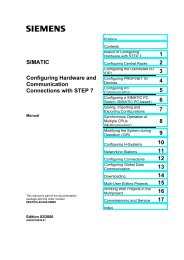II - DCE FEL ČVUT v Praze
II - DCE FEL ČVUT v Praze
II - DCE FEL ČVUT v Praze
You also want an ePaper? Increase the reach of your titles
YUMPU automatically turns print PDFs into web optimized ePapers that Google loves.
SIMATIC S7 Ex Analog Modules<br />
Interference rejection, error limits<br />
Interference voltage rejection for f = n x (f1 1 %),<br />
(f1 = interference frequency)<br />
Common-mode rejection<br />
(UISO < 60 V)<br />
> 130 dB<br />
Normal-mode rejection<br />
(interference peak value<br />
< rated value of input<br />
range)<br />
> 40 dB<br />
Crosstalk attenuation between<br />
inputs (UISO < 60 V)<br />
> 70 dB<br />
Operational limit (in total temperature range, referred to<br />
input range)<br />
25 mV<br />
0.09 %<br />
50 mV<br />
0.06 %<br />
80 mV<br />
0.05 %<br />
250mV/500mV/1V 0.04 %<br />
Basic error (operational limit at 25C, referred to input<br />
range)<br />
25 mV<br />
0.018 %<br />
50 mV<br />
0.014 %<br />
80 mV<br />
0.011 %<br />
250mV/500mV/1V 0.008 %<br />
Temperature error (referred to input range)<br />
25 mV<br />
0.0019 %/K<br />
50 mV<br />
0.0013 %/K<br />
80 mV<br />
0.0011 %/K<br />
250mV/500mV/1V 0.0010 %/K<br />
Linearity error<br />
(referred to input range)<br />
0.003 %<br />
Repeatability (in steady-state<br />
condition at 25C,<br />
referred to input range)<br />
3-60<br />
0.003 %<br />
Interference rejection, error limits continued<br />
The accuracy of temperature<br />
measurement with external<br />
compensation with thermal<br />
resistors is derived from:<br />
The accuracy of temperature<br />
measurement with external<br />
compensation with<br />
compensation box is derived<br />
from:<br />
The accuracy of temperature<br />
measurement with<br />
compensation of the external<br />
reference junction maintained<br />
at 0C / 50C is derived from:<br />
The accuracy of temperature<br />
measurement with internal<br />
compensation (terminal<br />
temperature) is derived from:<br />
– Error for analog<br />
input of the type of<br />
thermocouple used<br />
– Accuracy 1) of the<br />
type of thermal<br />
resistor used for<br />
compensation<br />
– Error 1) of<br />
compensation input<br />
– Error for analog<br />
input of the type of<br />
thermocouple used<br />
– Accuracy 1) of<br />
compensation box<br />
– Error 1) of<br />
compensation input<br />
– Error for analog<br />
input of the type of<br />
thermocouple used<br />
– Accuracy 1) of<br />
reference junction<br />
temperature<br />
– Error for analog<br />
input of the type of<br />
thermocouple used<br />
– Accuracy 1) of<br />
internal reference<br />
junction<br />
temperature 0.5 K<br />
1) Due to the constant increase in the thermocouple characteristic at higher temperatures, the error in the compensation<br />
element is less effective than at temperatures in the vicinity of the compensation temperature. Exception: Thermocouple<br />
types J and E (relative linear progression)<br />
Due to the little increase in the range from approx. 0C to 40C, the lack of compensation of the reference junction<br />
temperature has only a negligible effect in the case of thermocouple type B. If there is no compensation and the<br />
measurement mode ”Compensation to 0C ” is set, the deviation in thermocouple type B during temperature<br />
measurement is between 700C and 1820C < 0.5C<br />
500C and 700C < 0.7C.<br />
”Internal compensation” should be set if the reference junction temperature closely corresponds to the module<br />
temperature. As a result, the error for the temperature range from 700 to 1820C is reduced to < 0.5C.<br />
I/O Modules with Intrinsically-Safe Signals<br />
C79000-G7076-C152-04
















